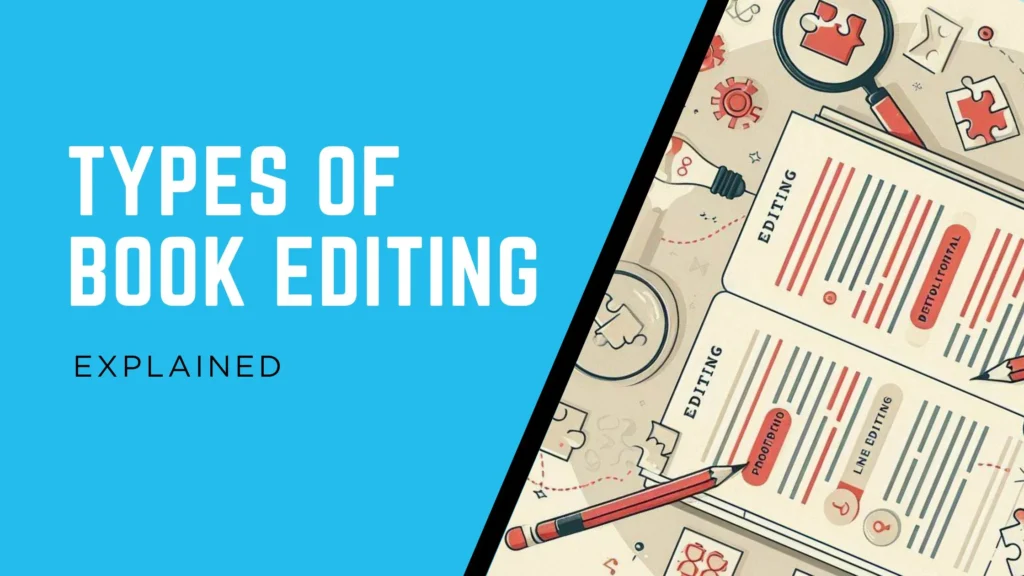Most writers may dread it, let’s face it, book editing is something you can’t bypass, no matter what. It is what makes your manuscript a book. What you wrote is a manuscript. It is scattered, contains errors of various kinds, and needs overhauls to be made into a publishable work. By collaborating with authors, editors address the gap between raw creativity and market-ready literature.
This blog is the ultimate beginner’s guide to book editing. Whether you are a new author seeking an editor or an experienced one, this guide will help you understand this crucial aspect of book publishing in detail.

What Is Book Editing and Why Is It Crucial for Authors?
Book editing is a multi-layered process and not just superficial polishing. It is an expert-guided process that involves making strategic revisions to the structure, style and substance of the manuscript.
Definition of Book Editing
Book editing is defined as,
The systematic refinement of a manuscript to optimize its readability, accuracy, and artistic merit. This process ensures that the author’s vision is communicated effectively while meeting industry standards for publication.
The Role of Editing in Publishing Success
The role of editing in publishing success is vital. It is the editing process that helps the author connect with their readers and helps the book thrive in competitive markets. The role of editors is not only to collaborate with authors but to critically evaluate elements like narrative flow, character development, prose clarity and stylistic consistency during different stages of editing. The book editing process elevates a book’s readability and credibility by eliminating plot inconsistencies, awkward phrasing, and factual inaccuracies. It is the book editing that transforms a creative vision or a scholarly work into a professional product that stands out in a saturated literary landscape
Common Misconceptions About Book Editing
Most authors either dread book editing or underestimate its transformative potential in the book publishing process. This happens due to a narrow understanding of the editorial process. Here are a few common misconceptions about book editing.
- Perhaps the most common myth is that editors correct typos and grammatical mistakes. This overlooks the multifaceted nature of the editing process that involves many steps.
- Another misconception is that editors rewrite the manuscript entirely, which completely erases the author’s voice, while in reality, editors collaborate with authors to amplify their voice.
- Only unskilled writers require editors. This misconception overlooks the benefits of professional feedback and the fact that most accomplished writers also undergo the editing phase to ensure logical consistency in their work.
The Different Types of Book Editing Explained
As mentioned earlier, book editing is a multifaceted process that involves various types and phases. Major types of book editing include developmental editing, line editing, copy editing, and proofreading, etc.

What is Developmental Editing?
Developmental editing is the foundational step of the editing process. It primarily focuses on the basic structure of the manuscript, addressing the coherence and consistency of the narrative.
It is on this stage that the manuscript’s structure is analysed to identify logical gaps, underdeveloped subplots or misaligned pacing. In nonfiction, editors verify that arguments build persuasively toward a central thesis, ensuring factual accuracy and logical flow. This process often involves creating an editorial report detailing strengths, weaknesses, and recommendations for restructuring scenes or refining themes.
When Developmental Editing Is Needed?
Typically, this stage is effective in the earlier parts of the writing process when the writer has the first draft ready, but chapter sequencing is yet to be done. This big-picture analysis helps authors deal with narrative direction or organizational challenges. For non-fiction authors, this stage helps correct the factual errors that are very harmful, especially for niches like health and finance. Academic authors also consult this stage when they are facing repeated rejections from journals to align their manuscripts with disciplinary standards.
Line Editing vs. Copyediting
The purpose of both line editing and copyediting is to enhance the clarity of the manuscript. However, they operate at different stages.
What is Line Editing?
Line editing focuses on the aesthetic qualities of prose, focusing on sentence rhythm, word choice, and tonal consistency. Paragraph transitions, redundancies and phrasing adjustments are scrutinised to help authors amplify their narrative. It is the job of the line editor to make the sentences as effective as possible while maintaining the author’s style. Therefore, sometimes line editing is called stylistic editing.
Line editing is the line-by-line close reading of the text to make it sharper and clearer. The line editor reads the piece as a careful reader to analyse how the writer’s word choice and syntax contribute to the overall tone.
What is Copyediting?
Copyediting, as the name suggests, focuses more on grammatical accuracy, adherence to style guides ( e.g Chicago Manual of Style) and consistency in punctuation, spelling and formatting.
Factual errors are corrected, timelines cross-checked, and terminology is standardised during this stage of editing. It is during this stage that unintentional shifts in point of view are flagged to ensure narrative continuity. Though the nature of editing is subjective, copyeditors try to be as objective as possible to maintain professional standards.
What is Proofreading?
It is the final stage of editing, where surface-level errors are checked to ensure the manuscript’s professional presentation.
What Proofreading Includes?
Proofreaders check typos, misplaced commas and formatting inconsistencies. The final script is compared with the previous edits to ensure no corrections were overlooked. In print publishing, this stage involves checking layout issues like widowed lines or page numbering. While for digital publishing, proofreading involves checking hyperlink functionality and text flow across different devices.
When Proofreading Is Needed?
It is the last and final step of the editing process. Any changes post-proofreading can be risky, especially for print publishing, where pagination is fixed. Therefore, it is always advised to make all necessary edits before proofreading to avoid any troubles later.
Final Word
Book editing is a very important process that helps author refine their text of all kinds of mistakes. The purpose of this process is to help the author gain more clarity and not rewrite the entire manuscript. It is a multilayered multiphase process that involves different stages and has different implications for different types of publishing. Only professional editors are recommended to avoid waste of time and money. To hire book editors or to know more, click here.




